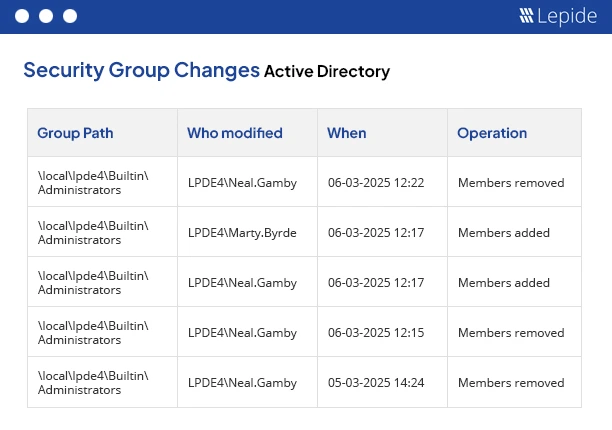
If you’ve recently completed Lepide’s Active Directory Security Self-Assessment free tool, you may be wondering what your score and grade mean.
It’s easy to get caught up in the numbers. But your Active Directory Risk Score isn’t a final grade; it’s a reflection of how your environment has quietly evolved. You didn’t wake up to discover that you have too many privileged users, inactive users, or old password policies. These issues develop over time when there is no dedicated Active Directory auditing solution in place.
Let’s walk through it, not as a checklist, but as a way of thinking more clearly about where your Active Directory stands today.
A Quick Walkthrough of Key Active Directory Risk Indicators
Inactive Accounts
Most organizations have more of these than they realize. An employee left months ago. A service account hasn’t been touched in ages. The account still exists. Still has access. Still inherits the same permissions it always did. It is not something uncommon, though it is risky. When your score picked up on this, it was not necessarily concerned with poor hygiene. It is a warning that the system may well be performing better at remembering than forgetting. And that is what is worth attention.
Admin Privileges
This is rarely deliberate. But it’s very common. During a project or a migration, or an emergency, people are granted access on a temporary basis, and it becomes permanent. As time goes by, you find yourself with a higher number of privileged users than you think. It is not just the issue of overexposure. It is the uncertainty. You do not necessarily know to whom something can be given, or why. And if this reflected in your score, then maybe you should get to those edges as well, before someone beats you to it.
Passwords That Never Expire
Sometimes this is done for convenience. Sometimes, because it’s just always been that way. But non-expiring passwords are low maintenance for the team, and high value for attackers. When you see this show up in your assessment, it doesn’t mean your password policy is broken. It only implies that certain aspects of it might have been left undisputed over long-standing periods.
Lack of Auditing
This one’s a bit different. It’s not about what’s wrong, it’s about what’s unknown. Not watching for changes to group memberships. Not seeing failed logons in real time. Not knowing if someone’s logging in over the weekend from a place they shouldn’t be.
The difficult part here is that you don’t notice anything until something happens. If your risk score highlights a gap in visibility, it’s a quiet reminder that problems don’t always announce themselves.
Login Failures, Lockouts, and Strange Timing
Sometimes these signals get dismissed as noise. But repeated login failures, unexpected lockouts, or after-hours activity without explanation, these patterns often come before bigger problems. If this area felt fuzzy in your report, it might not be about risk. It might be about resolution. If something unusual happens, can you trace it clearly? Can you explain it?
Policy Drift
Security decisions made five years ago might still be running today. Not because they’re the best choice, but because no one’s gone back to check. Old password policies. Infrequent audits. Manual processes that were meant to be temporary.
If you noticed a drift in your report, you’re not alone. It’s one of the most common causes of exposure, not because no one’s paying attention, but because so much else takes priority.
So, What Should You Do With Your Score?
You don’t need to panic. Most environments land somewhere in the moderate zone. A mix of good practice and lack of visibility.
But the results can give you clarity about where you stand, and where things are quietly leaning too far. Some of it you may already know. Some of it might be new. Either way, this is a chance to step back and ask: What are we seeing? And what are we just assuming is fine?
If several indicators appear as high risk, consider whether your current tools or your current level of visibility are sufficient.
And this is where Lepide comes in, not as a fix-all, but as something built specifically to surface these kinds of gaps, continuously, without adding more noise or workload.
You don’t need to change everything overnight. But if the report gives you pause, there’s value in exploring what support looks like, whether that’s better internal processes or the right platform to keep the lights on across your Active Directory.
Now you have a clearer picture of where your Active Directory stands. The next step is exploring how to act on it. Whether it’s tightening permissions, cleaning up inactive accounts, or simply gaining better visibility, you don’t have to do it manually or alone.
A free trial of Lepide Active Directory Auditor can help you go beyond the score, giving you live insights, automated detection, and practical ways to reduce risk where it matters most.

